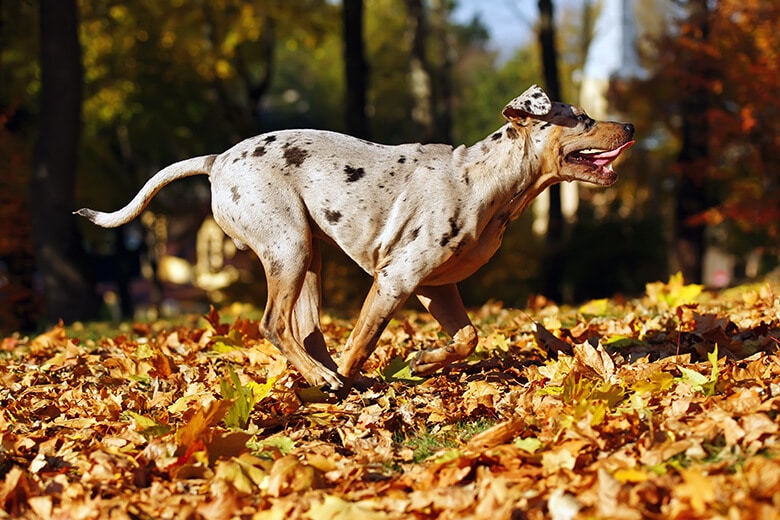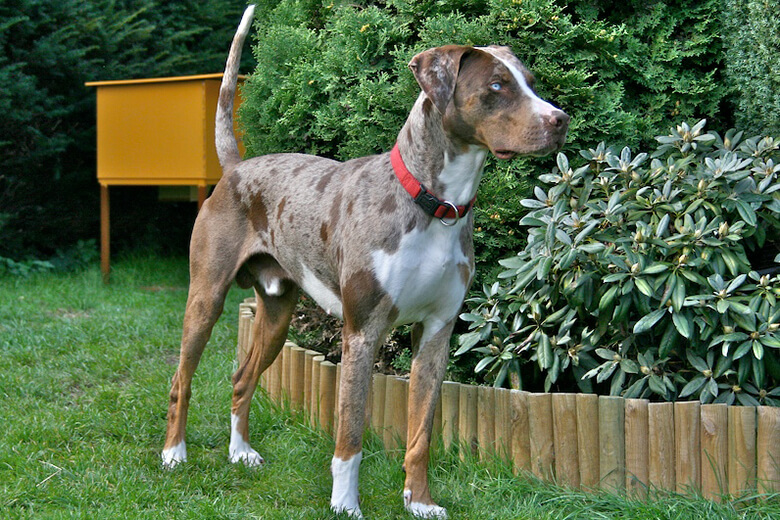For some, the Catahoula Leopard Dog could be the perfect dog, but there are some things you need to know about the breed first.
Known for their hardworking, rugged demeanor, these beautiful dogs are also affectionate, gentle and loyal to their family.
They are known for their varied coat colors, which can be black, brindle, black merle, red merle, red, yellow and coat patterns, including spotted, brindle, solid or patched. They have vivid eye colors and some dogs have two different colored eyes. Originally from Louisiana, these dogs are strong, independent dogs bred to work in rough environments driving hogs and cattle. These dogs need something to do, so if you don’t have farm animals, canine sporting events like agility will keep the breed happy.
Related: Dogs Around the World: Meet the Dogs of Finland — and Why They Are So Famous
These dogs can be aggressive to other dogs, so early socialization is crucial. If you do get another dog, it is often recommended to get one of the opposite sex. While the Catahoula Leopard Dog can get along with cats if raised with them, it’s not necessarily a good idea. The same goes for having a small dog in the same household. Because of their temperament, they should only be off-leash in a fenced area.
If you have the space for this breed to get plenty of exercise, here are some facts about the Catahoula Leopard Dog.
Height: 22–23 inches (male), 20–24 inches (female)
Weight: 35–110 pounds (male), 35–99 pounds (female)
Average Lifespan: 10-14 years
Origin: The Catahoula Leopard Dog may sound exotic, but it’s an American dog breed named after Catahoula Parish in Louisiana. The breed is the official state dog of Louisiana. The only breed to have originated in Louisiana, the word “Catahoula” means “sacred lake” in the Choctaw language.
This breed has a fascinating history: when the first pioneers landed in Louisiana, they discovered that the heavily forested land was heavily inhabited by wild hogs. They bred Mastiffs, Bloodhounds and Greyhounds that had brought there by Spanish explorers with the dogs of local Native Americans, who called the resulting breed “wolf dogs.” When French explorers arrived, they bred these wolf dogs with their own breeds, possibly including the Beauceron, to produce the breed known today as the Catahoula Leopard Dog.
Related: Everything You Need to Know About the Bernese Mountain Dog
Bred for: These dogs were originally bred as hunting and then herding dogs to round up and pen wild boars and escaped livestock like cattle that were living in the woods. These dogs have a unique herding technique that is different from other herding breeds: They use intimidation and aggression to manage their herds, using an organized, coordinated team effort of (ideally) three dogs that surround the animals. It is fast-paced and extremely dangerous, and each dog must remain alert and aware of the exact position of the other dogs and the pig, for one wild pig can kill all three dog in seconds.
Temperament: Even tempered, energetic, intelligent and assertive rather than aggressive, they can make good family dogs as long as they’re not isolated. These dogs are not “outside dogs”; they thrive on lots of companionship. They make great watchdogs, and if raised with children, these dogs will become their lifelong protectors. They can be headstrong and territorial, so early socialization is imperative. Intelligent and energetic, this breed needs an experienced, loving trainer (as all dogs deserve), as they will not allow anyone to mistreat them, but will respond with assertive self-defense. This breed is strong-willed, and training should be a continual activity over the course of their life. As family dogs, they are affectionate, loyal and gentle.
Grooming: This breed is easy to groom. Though they are moderate shedders, they only need to be brushed about once a week. Give them a bath a few times a year (unless they get into something nasty), trim their nails regularly and keep the teeth clean.
Related: 6 of the Most Popular Dog Breeds That Are Also Super Expensive
Exercise: This is not a dog for couch potatoes! If they aren’t working as herding dogs, you should aim for at least one hour of strenuous activity a day. Activities like hiking, jogging, swimming, long-distance running, and games like fetching and Frisbee will keep these dogs happy. They enjoy running around in a fenced in area (or they will take off tracking any small wildlife), and any opportunities, however occasional, for tracking and herding.
Health: There’s good news here: the Catahoula Leopard Dog is a generally healthy breed. They may be susceptible to hip dysplasia and eye diseases. Because they may carry the gene for merle coloration, which is linked to deafness, some can be deaf in one or both ears.
Places to get a Catahoula Leopard Dog: If you decide to rescue this breed, try to find out the dog’s history. If this breed ended up in rescue because of a specific behavior concern, it will be important to be prepared with either training, a behaviorist or both. People will abandon this breed because they don’t know how to train them.
You can adopt a Catahoula Leopard Dog from these rescue groups:
Catahoula Rescue Me
Catahoula Rescue Northeast
Houlas and Heelers
Pet Adoptions by Overtock
Catahoula Rescue of New England
If you want to adopt a puppy from a breeder, make sure the breeder is responsible with a good reputation. They should welcome any questions you have about the parents, genetic testing, and temperament.
The breeder should be able to provide you with these health certificates from the parents and the puppy:
- a certificate from the Orthopedic Foundation of America (OFA) or PennHip certifying the dog to have normal hips
- a certificate from the OFA BAER (brainstem auditory evoked response) evaluation for deafness.
You can also request:
- a certificate from the Canine Eye Registry Foundation (CERF) – dated within the past year – certifying the dog to be free of eye diseases
In general, do not purchase a puppy from a breeder who cannot provide you with written documentation that the parents were cleared of health problems that affect the breed. Don’t settle for a breeder who says the dogs were checked by vet, which is not a substitute for genetic testing.
Do your research about breeders. Check out the NALC, the National Association of Louisiana Catahoulas.
Related: Surprise, Surprise: the Labrador Is Again the Most Popular Breed in America



















